Elegant and congruous: How Hartland Abbey draws together eight centuries of architectural and family history
John Goodall looks at the history of Hartland Abbey in Devon after the Reformation, and its descent in the hands of one family to the present.
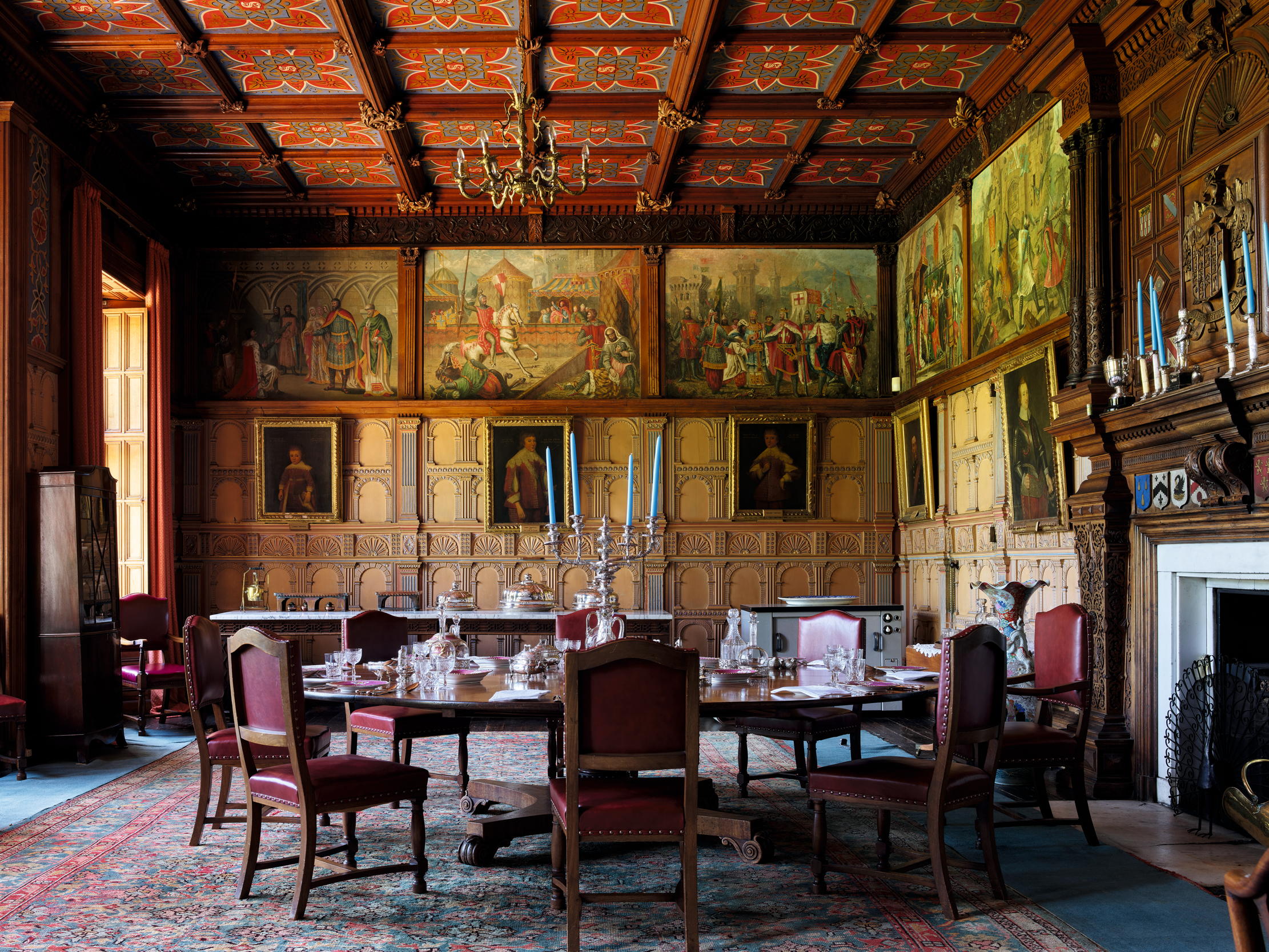

N.B. This is the second of two recent articles on Hartland Abbey — the first was by David Robinson on the medieval foundation of Hartland Abbey.
In the late spring of 1796, the Revd John Swete, of Oxton House, near Exeter, set off on a tour of the north coast of Devon. A tireless traveller in the county and an admirer of the Picturesque, the journal of this wealthy clergyman notes his encounter near the village of Hartland with a Gothic lodge ‘at the opening of a narrow valley, surrounded by trees, and overrun with ivy’. Turning into the valley on a newly created drive, he descended through woodland, accompanied by a ‘little gurgling trout stream’, and emerged from the trees to see a full view of the ‘noble seat’ of Hartland Abbey. ‘The pile had an elegant and magnificent appearance, and having assumed to itself the Gothic style of architecture, seemed to be congruous in all its parts.’
He settled down to draw the house from the east and west, views that remain little changed to day. The setting, he enthused, was ‘uncommonly picturesque’ with ‘rising hills, richly overspread with woods’ and the valley between them filled by the house as if ‘absolutely to block it up’. Continuing on: ‘I found that the stream had risen into some importance, and the valley become more beautiful, as in approaching towards the sea, it spread itself out.’ As a crowning flourish, the parish church tower ‘finely ornamented with pinnacles and fretwork’ commanded the whole valley.
‘Whilst contemplating the beauty and situation of the church and tower,’ the Revd Swete continued, ‘a servant came to me, and in the most civil terms, requested that I would take refreshment: his master was from home, but his mistress would be glad to see me! The time of the day and the prospect of a long ride through an unknown and almost an untravelled country prevented my acceptance of this polite offer.’ All he added to his description, therefore, was that a medieval abbey — described in last week’s issue — had ‘stood on the site of the present mansion’, and that ‘its remains had given place about 20 years ago to the present more commodious edifice… except a small part which has been incorporated in the new house’.

Despite his failure to enter Hartland Abbey, Swete did better than the vast majority of Devon antiquaries and diarists of the 17th and 18th centuries, most of whom — including Edward Prideaux, Francis Grose and Samuel and Nathaniel Buck — failed to visit at all. As a result, and in the absence of much documentation, the evolution of the house over the two centuries following the Reformation is difficult to piece together. Remarkably, despite repeated descent through the female line, it has never been sold.
In 1546, in the last year of Henry VIII’s reign, the buildings of Hartland Abbey and the bulk of the estate were granted to one William Abbott. He is described as the sergeant of the [King’s] Cellar, but is almost invisible in the documentary record. It’s likely that Abbott presided over the destruction of the abbey church, leaving only the stump of its western tower. Otherwise, he adopted the hall and great chamber formerly occupied by the abbot in the western cloister range as the heart of his new residence. Either Abbott — or possibly one of the last abbots — also constructed a wing projecting from this to the north-west. Additional domestic rooms were created in the adjoining claustral ranges, which were adapted as necessary. Abbott died in 1570 and his son, also named William, undertook the construction of a quay at Hartland that played an important role in the prosperity of the estate before the arrival of the railway.
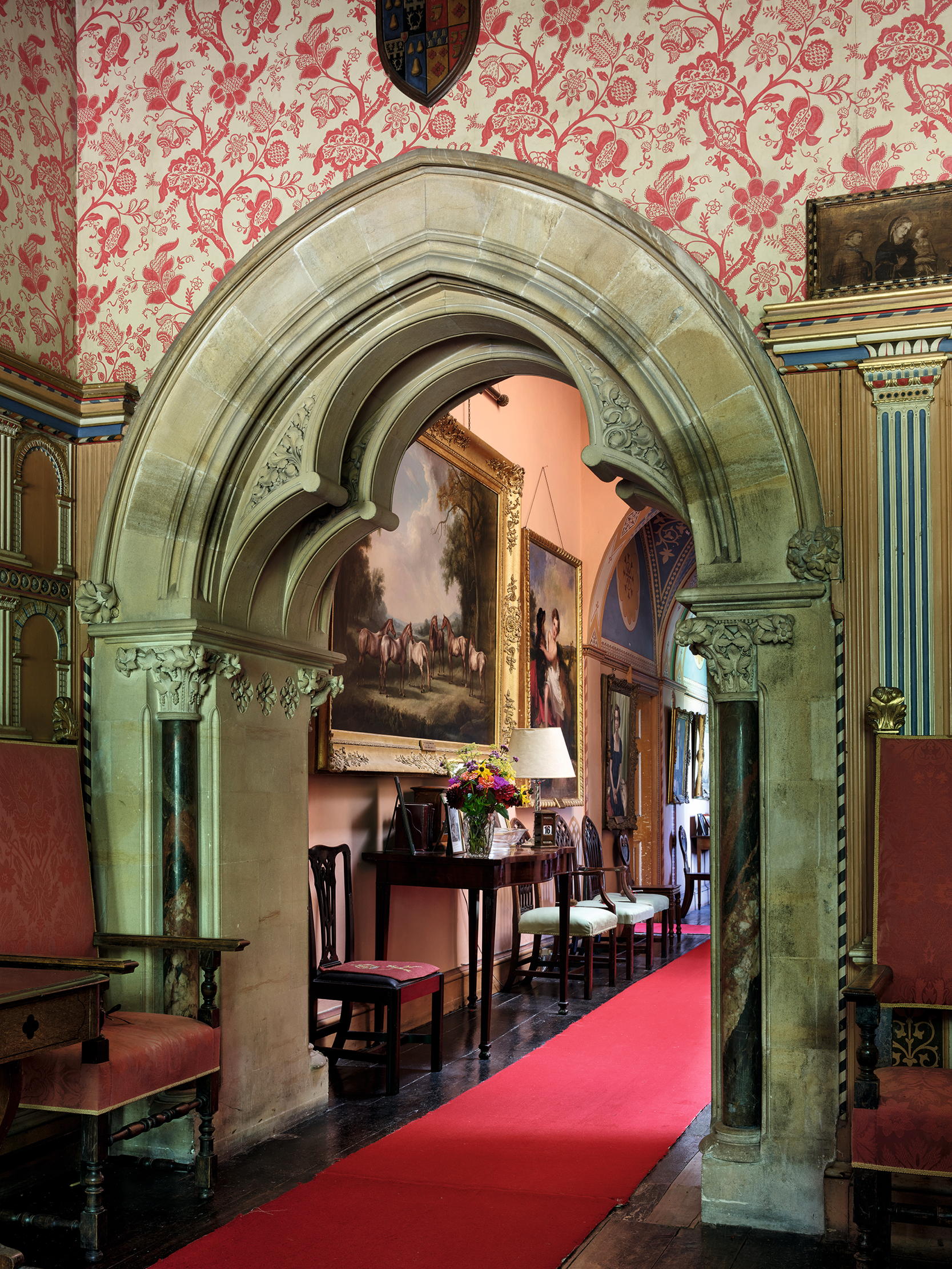
There are a few subsequent references to the form and furnishing of the house in the following century. In 1609, for example, the will of Abbott’s great-nephew refers to new wainscotting. Then, in 1636, an indenture issued by Nicholas Luttrell, an heir to the property through the female line, refers to ‘table bords and levery tables belonging to the great chamber and parlour’, as well as the ‘newe greate chamber at the east end of the gallery’. The gallery occupied the first floor of the south cloister range, which locates the great chamber in an unusual position well away from the main body of the house.
Exquisite houses, the beauty of Nature, and how to get the most from your life, straight to your inbox.
How well the monastic buildings had survived is startlingly illustrated in a survey produced following the marriage of the Luttrell heiress, Mary, to one Paul Orchard in 1702. Orchard, a local customs official and MP, was a wealthy man and consolidated his ownership of the wider manor. The survey, which includes a bird’s-eye view, plan and elevations, shows that the western claustral range of the abbey remained completely intact, together with the whole extent of the south cloister (with its gallery) and a section of the cloister walk to the north (connecting to the surviving stump of the abbey church tower).
One important change it records, however, was the addition of a second wing at the south-west corner of the west or entrance façade. This wing was proportioned to balance its 16th-century predecessor and helped regularise the outward appearance of the building. The medieval fenestration of the abbey buildings seems to have remained largely intact, but the new wing possessed sash windows and a hipped roof. Its surviving interior fittings, including a panelled parlour, staircase and decorative plasterwork, suggest that it was built by Orchard soon after his marriage.
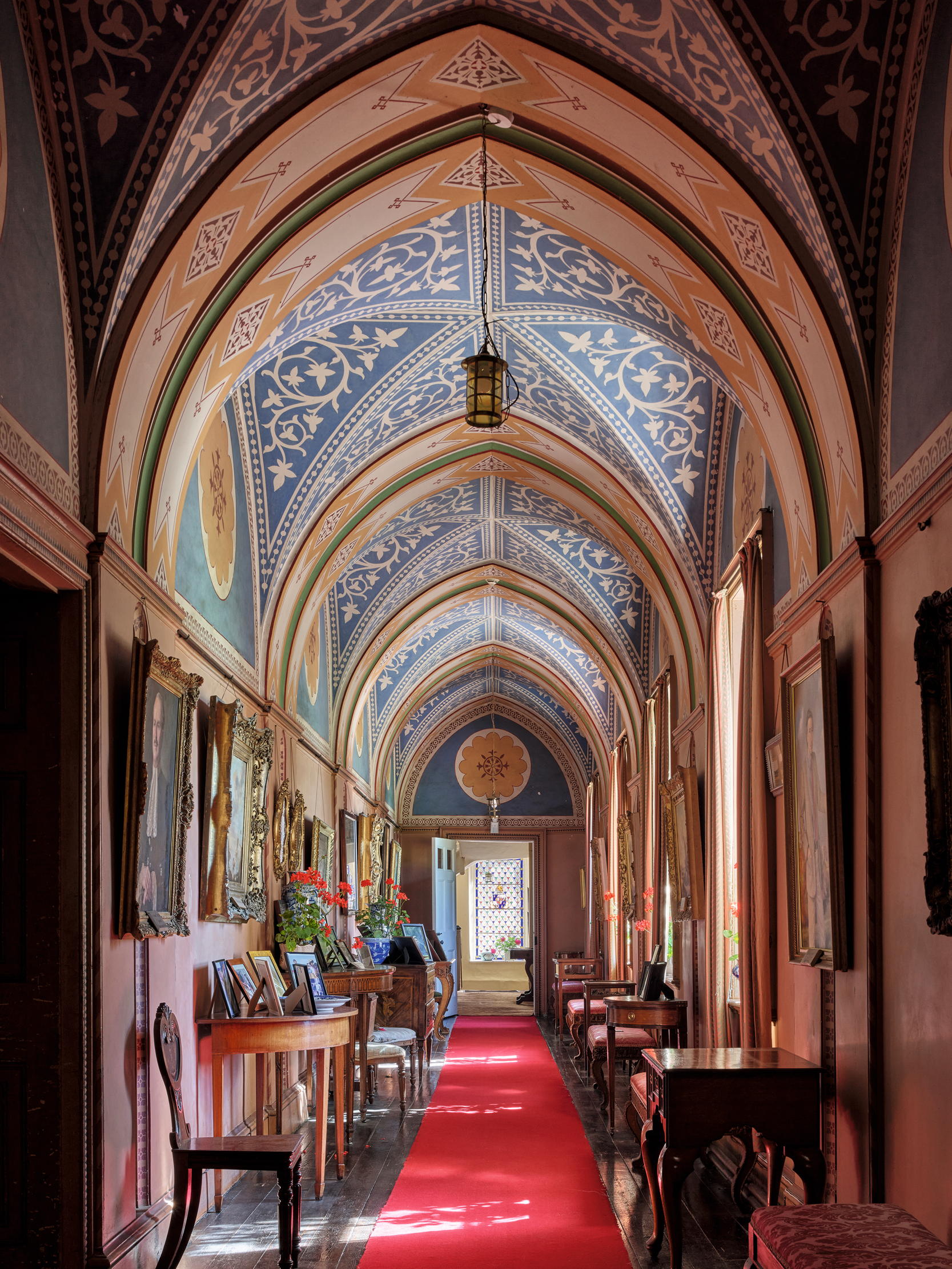
The survey also depicts an extensive formal garden including parterres in a large entrance court and a yard filled with exotic birds. Some of the dividing walls could be medieval survivals. A letter of 1738 written by a close family friend, Revd James Hervey, describes it as ‘enriched with fruits, and beautified with flowers’. He notes ‘a curious sort of artificial wilderness made of elms and limes planted in rows, cut into form, and uniting their branches. In the midst is a fountain large enough to swim in and a little engine playing the waters. On each side are arbors for shade — in various parts, seats for rest’. All he could find to say of the house was that it had an ‘antique, grave, and solemn aspect’.
Orchard died in 1740, less than a year after his heir and namesake — to whom Hervey stood as godfather — was born. It was probably after the younger Paul Orchard came of age in the late 1750s that the next round of changes to the house took place (or were planned). These are only known from a pair of watercolours dated a century ago by the authoritative local historian Richard Chope to 1767 (although no inscription is now visible and he gives the same date to a third, stylistically distinct view). They show the entrance front regularised and provided with a central front door approached up a flight of steps, as well as carriage access across the entrance court to a monumental stable block beyond.
Confusingly, it’s just possible that these two watercolours record intended, rather than executed, changes that followed Orchard’s marriage — ultimately childless — to Bettina Lawley in 1764. That’s partly because they contradict each other in some odd details (the gate piers, for example, are variously capped by urns or obelisks) and because they constitute the only evidence for the existence of this stable block, which is out of all proportion and oddly detailed, with sash and Diocletian windows. Perhaps Orchard’s well-attested enthusiasms for hunting and the local militia explain the scale of this building.

Whatever the case, these alterations were a modest prelude to sweeping changes in the next decade. A foundation stone simply and clumsily inscribed ‘P. Orchard Esq. Colonel of the Reg[iment] of Devon Mil[itia] laid this stone March 6 1779’ marks their inception. Work was overseen by John Meadows, a West-minster architect and surveyor active in Devon from 1770. The new house was cast in a fashionable Gothic idiom appropriate to its history, but it was planned with a ruthless disregard for the inherited fabric. The remnants of the north and south cloister ranges were swept away and the abbot’s house cannibalised to create a regularly planned residence.
All that remains visible of the medieval fabric was absorbed within the basement of the new building. Its outer walls were rebuilt, incorporating the heavily reworked arches of the demolished cloisters. The plan of the house was also reversed, with the front door being moved from the west to the east side of the building. It gave access to a central hall at first-floor level with flanking reception rooms. These were connected to the rear by a two-storey corridor stretched between the wings of the former entrance court. At the same time, the main body of the house was raised by a storey, crowned with battlements and a central pediment. It was also brightly stuccoed. The best preserved of the late-18th-century interiors is the library (Fig 5), which is also in a Gothic idiom.
It was soon after these changes that Swete visited. He was narrowly beaten by the antiquarian Revd Richard Polwhele, who gives another brief account of Hartland Abbey in The History of Devonshire (1792). Both men — who knew each other as co-founders of an Exeter literary society — describe the attempted demolition of the west tower of the abbey church during Orchard’s building works. The extant stump proved almost indestructible and its unyielding remains had to be buried, leaving the house in its naturalised setting.
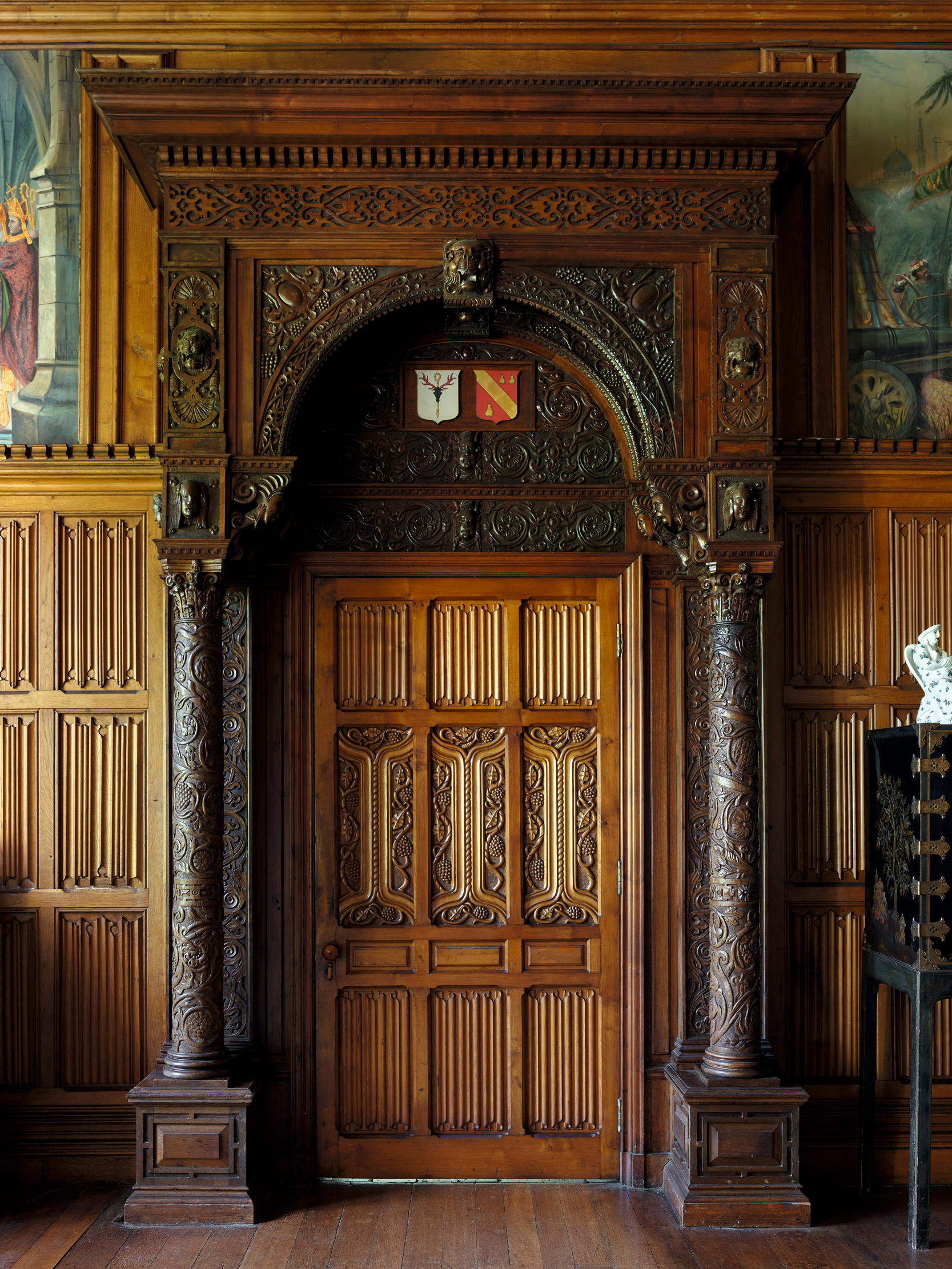
After the death of Orchard, Hartland was inherited in succession by two nephews. The second, Lewis William Buck, already enjoyed considerable property in Devon and continued to occupy his own nearby seat at Daddon House. In 1835, therefore, he passed Hartland Abbey to his eldest son, Col George Buck, and his first wife, Lady Elizabeth O’Brien, a daughter of the Marquess of Thomond. Buck clearly had a keen enthusiasm for the romantic antiquarianism of the period and restored both the gatehouse of another Devon family house, Affeton Castle, and the parish church of Hartland, in both cases employing the Exeter architect David Mackintosh.
The same architect probably oversaw the adaptation of the main reception rooms of Hartland in the 1850s. As well as inserting bay windows in the drawing room and dining room (Fig 1), both rooms were decorated with Jacobethan doorcases, panelling and chimneypieces, some of them possibly recycled (Fig 6). The rooms were further adorned with a cycle of oil paintings depicting historical scenes (Fig 2). These were executed from 1852 by the Exeter stained-glass artist Alfred Beer (Country Life, December 2, 1993). The careful research that informed the images was drawn together in a manuscript entitled Frescoes at Hartland Abbey.
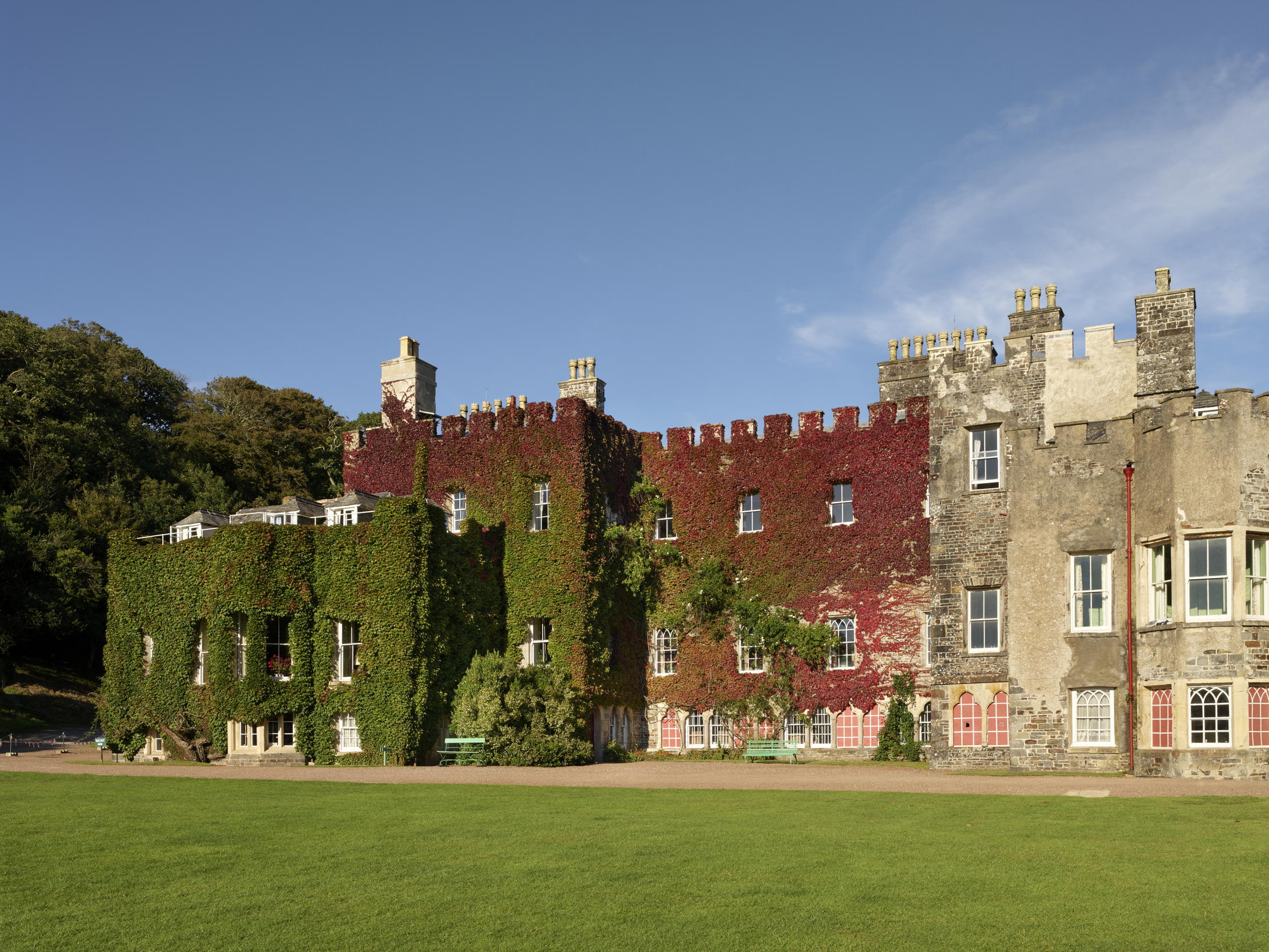
After the death of his father in 1858 and the offer of a baronetcy by Disraeli the following year, Buck chose to celebrate his own ancestral connections with the Stucley family by assuming their name and arms. Further alterations to the house followed from 1862 at the direction of Sir George Gilbert Scott, who created the present porch (Fig 3) and lobby at the north end of the building, fitted out with recycled panelling. He also recast the 18th-century corridors with vaults (Fig 4). The work constituted the last major physical changes to the house, which weathered successfully the challenges of the 20th century.
Since 1983, Sir Hugh and Lady Stucley have been exemplary custodians of Hartland Abbey. Recent improvements include an exhibition area in the basement that features an ambitious display on the 17th-century antiquarian William Stukeley, an ancestor and celebrated early investigator of Stonehenge. During the pandemic, the failing asbestos roof was completely replaced in slate and lead to the highest standard. It hopefully guarantees the immediate future of this extraordinary house, the fabric of which so magnificently draws together eight centuries of architectural and family history.
Acknowledgements: A. Ellis and Lady Stucley
Visit www.hartlandabbey.com

John spent his childhood in Kenya, Germany, India and Yorkshire before joining Country Life in 2007, via the University of Durham. Known for his irrepressible love of castles and the Frozen soundtrack, and a laugh that lights up the lives of those around him, John also moonlights as a walking encyclopedia and is the author of several books.